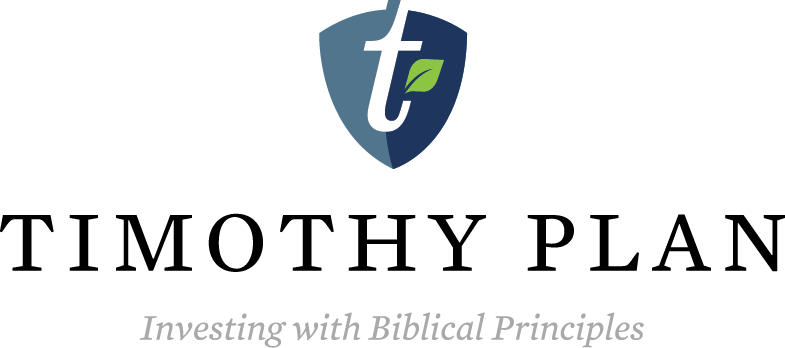International 2Q18
June 30, 2018
Recent Posts
- A Businessman Who Really Did Give it All Over to GodSeptember 28, 2022
- A 'Screwtape' Approach to Keeping Christians from Biblically Responsible InvestingSeptember 21, 2022
- Both Inflation and Inaction Are UnbiblicalSeptember 14, 2022
- Misunderstood in the NeighborhoodAugust 18, 2022
- Billy Graham was the inspiration for the new BiblegraphAugust 9, 2022
- A Businessman Who Really Did Give it All Over to God
Categories

Investing involves risk, including the potential loss of principal.
Before investing, carefully consider the fund’s investment objectives, risks, charges, and expenses of the investment company. This and other important information can be found in the fund’s prospectus. To obtain a copy, visit TIMOTHYPLAN.COM or call 800.846.7526. Read each prospectus carefully before investing.
Because the Timothy Plan Funds do not invest in excluded securities, the Funds may be riskier than other funds that invest in a broader array of securities. There are risks when a fund limits its investments to particular sized companies, and all companies are subject to market risk. The Fund recently experienced significant negative short-term performance due to market volatility associated with the Covid-19 pandemic.
MUTUAL FUND INVESTOR
To read more about our mutual funds, please click this link to access fund information, including the prospectus, fact sheets, performance, and holdings for each fund.A prospectus is available from the Fund or your financial professional that contains more complete, important information. Please read it carefully before investing. Mutual Funds distributed by Timothy Partners, Ltd. Member FINRA.
HEADQUARTERS: 1055 Maitland Center Commons, Maitland, FL
(800) 846-7526 | Send an email | View our mapMUTUAL FUND SHAREHOLDER SERVICES: c/o Ultimus Fund Solutions, Post Office Box 541150, Omaha, NE 68154-1150
(800) 662-0201 | Account AccessETF INVESTOR
To read more about our ETFs, please click this link to access fund information, including fact sheets, performance and holdings for each fund. A prospectus is available from the Fund or your financial professional that contains more complete, important information. Please read it carefully before investing. ETFs distributed by Foreside Fund Services, LLC, Member FINRA. Timothy Partners, Ltd. is not affiliated with Foreside Fund Services, LLC.
ETF SHAREHOLDER SERVICES: Contact your financial advisor for information regarding your account.






Market Backdrop
Monetary policy normalization in the U.S. and Trump’s trade war led to significant volatility for equity markets during the quarter. The U.S. 10-year bond yield crossed over the psychological 3% barrier during the quarter before falling back below that level as risk aversion took hold. The yield curve continued to flatten in the U.S. and some became concerned that the Federal Reserve’s continued hike cycle over the coming 12 months could lead to an inverted yield curve causing much concern. The U.S. Dollar bounced back strongly during the quarter as trade tensions and monetary policy normalization reduced investor confidence in emerging markets. The U.S. Dollar Index rose by 5% versus major currencies for the quarter. Currencies in the emerging markets declined significantly with the Brazilian Real, the South African Rand and the Turkish Lira all falling more than 13% versus the dollar during the quarter. The Argentine Peso also went into a tailspin, prompting the central bank there to raise interest rates by more than 1000 bps and ultimately asking the IMF for support.
President Trump’s trade war took hold as he initiated tariffs on aluminum and steel products from various countries. In addition, a 25% tariff was placed on $50bn worth of goods from China as the U.S. government fights back against intellectual property theft and China’s perceived unfair trade practices. This significant development led to equity price volatility around the world as the uncertainty of the trade war may lead to inflation pressures and delayed investment plans. The trade disputes are likely to continue while Trump presses ahead with announcements of additional tariffs on Chinese goods. Thus far the Chinese have announced tit-for-tat tariffs and have threatened quantitative and qualitative retributions. Oil prices continued their ascent in the quarter as the Trump administration pulled the U.S. out of the Iran nuclear pact that could lead to curtailed oil volumes from the country. Prices rose despite Russia and OPEC’s decision to increase production, mostly to balance the markets from anticipated lost Iranian volumes and as the oil markets had become more balanced since their initial cut.
Mid-caps slightly outperformed small and large caps for the quarter while growth continued to outperform value. The best performing MSCI EAFE countries for the quarter were Israel, New Zealand, and Australia while the worst performing were Austria, Singapore, and Italy. For the year-to-date period, the best in MSCI EAFE thus far are Finland, Israel, and Norway while the worst are Austria, Denmark, and Germany. The best performing emerging market countries for the quarter were Colombia, Qatar, and India while the worst performing were Brazil, Turkey, and Pakistan.
Performance and Attribution
The Timothy Plan International Fund struggled a bit during the quarter versus the MSCI EAFE index. Stock selection hurt relative performance with stocks in the Consumer Discretionary, Utilities, Financials, and IT sectors all underperforming for the quarter. The portfolio’s small exposure to emerging markets was also detrimental to performance as EM equities underperformed in the quarter. Country allocation was hurt by EM exposure while stock selection in Japan and France was negative. On the positive side, stock selection in Norway and Spain helped the portfolio.
Outlook
Near term volatility is likely to remain in the equity markets as trade concerns, EM currency weakness on the back of rising US rates and stronger USD, and talk of less accommodative monetary policies in developed markets translate to added uncertainty for investors. We remain constructive longer term but cautious in the near term. US economic growth is leading the developed world while European and Japanese economic data have softened somewhat from earlier highs but remain above trend. Valuations are supportive of international equities, but near-term volatility and emerging market contagion fears is negatively affecting investor confidence.